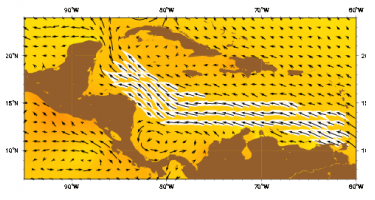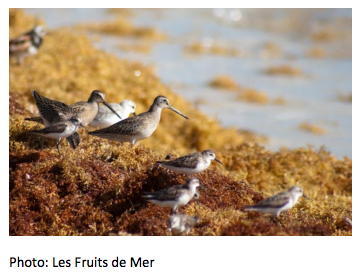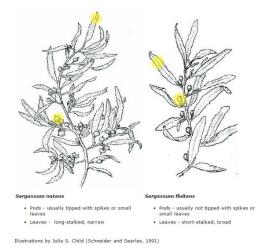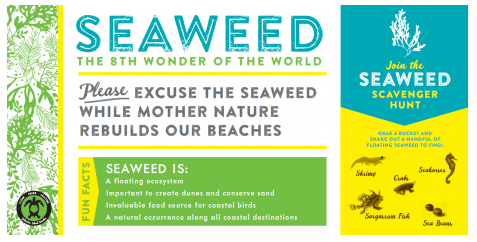Article courtesy: Doyle, E. and J. Franks. April 2015. Sargassum Fact Sheet. Gulf and Caribbean Fisheries Institute. | Please click here for original document.
Sargasssum Fact Sheet
Have you noticed an occurrence of greater than normal amounts of sargassum on your beaches in recent years? Has it caused problems for you or local communities? Are other people in your country or island talking about sargassum?
Sargassum is an emerging issue on the coasts of the Wider Caribbean
During 2011, massive quantities of pelagic sargassum occurred throughout the Caribbean, impacting aquatic resources, fisheries, shorelines, waterways, and tourism. A similar event occurred in 2014 and continues in 2015. This Fact Sheet seeks to share the state of knowledge about the sargassum influx and to promote the adoption of best management practices. Some of the questions that we’re frequently asked are:
What is it?
Pelagic sargassum is a brown alga, or seaweed that floats free in the ocean and never attaches to the ocean floor. These free-floating forms are only found in the Atlantic Ocean. Sargassum provides refuge for migratory species and essential habitat for some 120 species of fish and more than 120 species of invertebrates. It’s an important nursery habitat that provides shelter and food for endangered species such as sea turtles and for commercially important species of fish such as tunas. There are two species of sargassum involved in the sargassum influx: Sargassum natans and Sargassum fluitans.
Where does it come from?
Sargassum travels on ocean currents. Scientists are able to determine where the sargassum comes from by back-tracking from its stranding location using ocean models and data on movements of satellite trackers that are deployed at sea. It is believed that the recent influxes are related to massive sargassum blooms occurring in particular areas of the Atlantic, not directly associated with the Sargasso Sea, where nutrients are available and temperatures are high. The sargassum consolidates into large mats and is transported by ocean currents towards and through the Caribbean.
Will the sargassum influx occur every year?
We don’t know for sure if it will happen every year, but currently proposed efforts to develop prediction and alert systems would help answer this important question. Signs from the Eastern Caribbean so far this year are that we’ll be seeing sargassum in the region periodically throughout 2015. Some scientists associate the cause of sargassum with higher than normal temperatures and low winds, both of which influence ocean currents, and they draw links to global climate change.
Will the influx happen all year round?
The sargassum does not necessarily affect the same location in the Caribbean all year. As it’s transported on currents it progressively affects different locations across the region. At any one time of the year there are multiple locations that can be affected.
Is it a problem to leave it to rot on the beach?
Sargassum occurs naturally on beaches, albeit in smaller quantities. It plays a role in beach nourishment and is an important element of shoreline stability. Sand dune plants need nutrients from the sargassum and sea birds, for example, depend on the sea life carried in the sargassum for food. During decomposition there will inevitably be a smell and insects around. The experience in locations that have left the sargassum on the beach is that it will eventually get washed away or buried in the next storm, with rain easing the smell. Leaving sargassum on the beach has proven to be the simplest approach, also avoiding potential negative impacts associated with beach cleaning.
Are there any human health concerns associated with sargassum?
Although it can smell as it decomposes, this process is not toxic to humans. Sargassum does not sting. Depending on the type of sargassum you’re seeing, you might feel the pointy ends of the buoyancy pods of Sargassum natans. When it decomposes on sand you might notice a black layer underneath, but this is normal and a sign of mother nature doing her work of incorporating the sargassum into the beach.
What can we do about it?
In embracing the challenge of sargassum, good communications between agencies and the private sector, with the press, and with locals and visitors is essential. Make sure everyone knows where clean beaches can be found. An example of sign posting comes from the Galveston Island (Texas) Park Board of Trustees:
In many countries, the law does not require agencies to remove seaweed since it’s not marine debris but is a natural part of the ecosystem. Where private sector capacity exists to clean beaches, coastal managers agree on balancing the importance of sargassum for natural processes and as life-giving nourishment for beaches and seabirds, with pressure to address negative impacts on communities. Establishing clear policies about where, when and how to clean beaches is the next step. A review of experiences from beaches affected by sargassum in the Gulf of Mexico at the 2015 Sargassum Symposium hosted by Texas A&M University Galveston Campus, NASA Stennis Space Center and Galveston Island Park Board of Trustees highlights that:
Patience is required, and be aware that it’s not necessarily desirable to clean beaches that are already facing a precarious erosion situation, that are essential habitat for sea turtle nesting or where grooming will increase windblown sand and worsen erosion;
Constant grooming of the beach for regular maintenance or for aesthetic purposes is discouraged due to very real risks of worsened beach erosion from physical damage of machinery and unintended collection of sand;
There is a difference between achieving a naturally clean beach and an over-sanitized beach;
Least intrusive practices are preferred – hand raking is preferable to machinery, beach raking equipment with a perforated conveyor belt is preferable to heavy construction equipment, and heavy tracked equipment like road graders are prohibited;
A mechanized beach rake can remove moderate quantities of sargassum on dry sand. When exceptional amounts occur (ie. in excess of 3 feet deep) then removal of just the upper layers of sargassum first with a front loader, without touching sand, can be followed by mechanized beach raking in order to reduce sand loss;
Front loaders must utilize a bucket level control indicator/float mechanism to prevent gouging of the beach; Beach cleaning should be done only in the presence of monitors who check for wildlife prior to any cleaning, and operators must respect no-go areas such as sea turtle or bird nests;
Adjust cleaning schedules to low tide and when wind and storms are less likely to immediately bring new influxes;
Consider public safety and avoid mechanical beach cleaning in the presence of fishers or beach goers;
Applying any chemicals to sargassum makes things worse and is hugely damaging to reefs and fish; Removal of sargassum should be to agreed areas and only along a minimum number of agreed pathways in order to avoid harming dunes and dune vegetation;
Collected sargassum can be usefully redistributed in areas affected by beach erosion. For example, the Coastal and Wetlands Ecology Laboratory of Texas A&M University Galveston Campus is trialing compacting sargassum in bales, burying them in eroded areas and planting dune vegetation on top;
It can also be used as mulch or compost – allow salt to wash out in the rain and mix with manure and soil;
Other uses are emerging – use as biofuel, fertilizer and livestock feed or fish food, for example;
Collection from the sea is difficult in practical terms and threatens the living ecosystem in the floating sargassum;
Adaptation strategies are needed, in some cases these are being encouraged by grants for sargassum innovation.
We can’t keep our heads in the sand about sargassum!
To report sargassum please go to http://www.usm.edu/gcrl/sargassum/sargassum.observation.form.php
For more information please contact sargassum@gcfi.org











